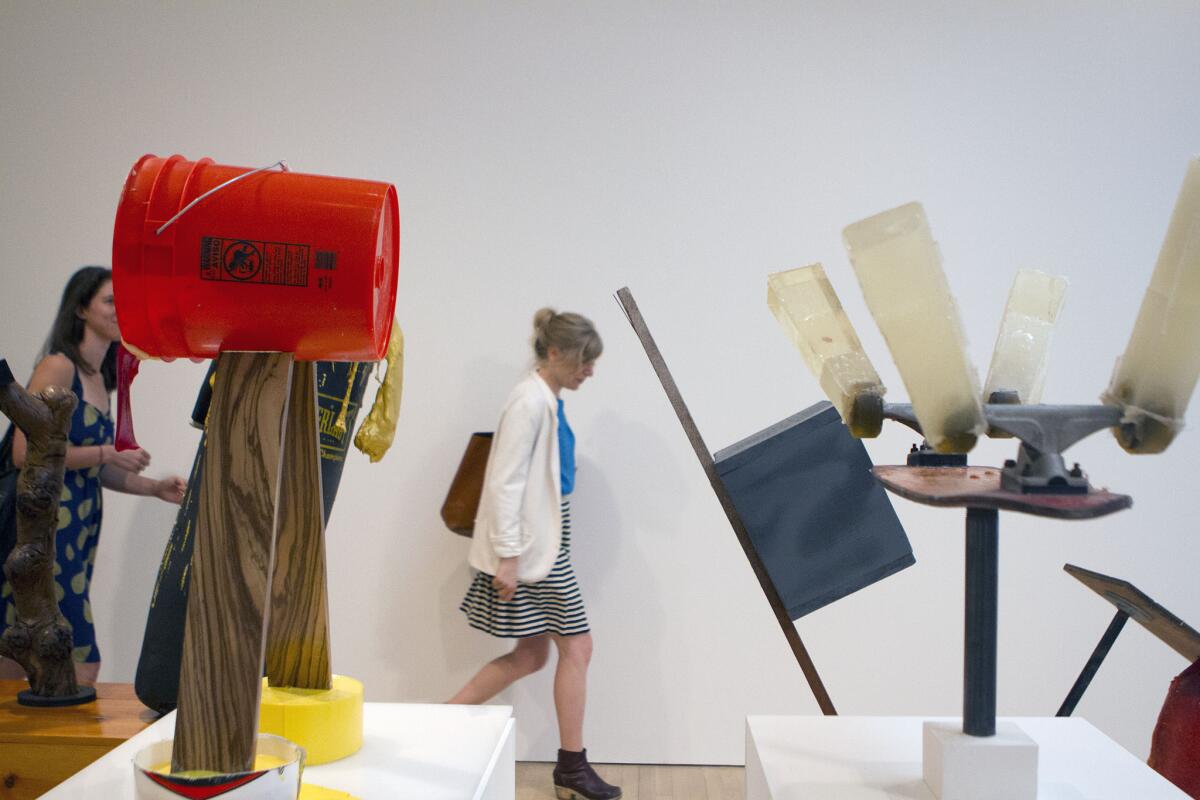Review: ‘Made in L.A.’ biennial art survey taps a social undercurrent

On the terrace at the UCLA Hammer Museum, artist Piero Golia is carving an enormous sculpture from white polystyrene foam. The ongoing public performance is part of the newly opened Hammer biennial, “Made in L.A. 2014,” on view through the summer.
When finished, the sculpture will be an enormous nose — specifically the nose of George Washington, carved to the scale of the first president’s head on Mt. Rushmore in the Black Hills of South Dakota. (It’s 21 feet long, slightly bigger than the noses of the other three presidents.) The Rushmore noses are said to have been made slightly larger than life because wind erosion would wear away the granite relief’s most prominent facial features, but that story is a matter of some dispute.
------------
FOR THE RECORD:
“Made in L.A. 2014”: In the June 19 Calendar section, a review of the Hammer’s “Made in L.A. 2014” survey and a photo caption misspelled the first name of artist Sarah Rara as Sara.
------------
When I saw the show early this week, all that was on the terrace were Golia’s materials — work bench, a trash can, some transfer drawings, a small model, a few tools, scaffolding and lights, plus a dozen big blocks of waiting foam. The project made me think of John Baldessari, who has been making “nose art” for 50 years, beginning with a painting that purports to show the nose of God floating aloft next to a lonely cloud in a bright blue sky.
Baldessari’s 1965 picture and title are a pun — “God Nose” — which rhetorically asked just what art should be at a time of raw cultural crisis.
Golia’s performance is titled “The Comedy of Craft.” God knows, a mordant humor lurks within the practice of making things by hand in a digital universe where a service economy struggles.
His nose, though, represents a secular founding father, not a religious one. The original Rushmore heads were a project born of the crazy excess of the Roaring ‘20s and, following the inevitable crash, completed during the grinding Great Depression. That painful history lends a certain topical poignancy to Golia’s absurdist pastiche today.
How Golia’s performance sculpture will turn out of course remains to be seen. But its submerged trace of American social distress does represent perhaps the strongest undercurrent in the biennial.
Organizers Connie Butler, chief curator at the museum, and independent critic Michael Ned Holte, who wrote a less-than-laudatory review of the inaugural 2012 biennial for Artforum magazine, have chosen 35 artists. That includes several artists’ collectives whose members collaborate.
The number is down considerably from 60 artists last time. According to catalog biographies, fewer than half have had solo shows in L.A. in the intervening two years (and many of those were at alternative venues). Under-exposed and emerging are the usual terms, but unfamiliarity lends some freshness to the exhibition.
Once again, the biennial meets my yardstick for a successful survey: At least a third should be worth seeing. No biennial can reasonably be expected to provide a coherent overview.
Rather than requiring three venues across the city as it did in 2012, this outing takes over all the Hammer’s galleries, plus several outdoor spaces. Happily, each artist gets a relatively self-contained space.
There’s even a small show-within-the-show — “Tony Greene: Amid Voluptuous Calm” — that gives a scathing historical face to the mess American society finds itself in today. (A separate Greene show also just opened at the MAK Center in West Hollywood.) The young artist died at 35 from AIDS complications, ending his work’s promising evolution in 1990.
“Amid Voluptuous Calm,” assembled by ONE National Gay & Lesbian Archives curator David Frantz, juxtaposes Greene’s found-photographs, embellished in thick overlays of Baroque patterns and letters in glossy paint, with work by several 1980s peers. The show is a stark reminder of a grim time marked by shocking government venality.
The biennial doesn’t have a theme, but an animating spirit seems to guide many selections. George Washington, the Great Depression, the so-called Reagan Revolution, official indifference to the AIDS pandemic, artists’ collectives — the show presses questions of the relationships between profoundly singular consciousness and deep social connectivity. The tensions between individual autonomy and commonwealth are fundamental to America’s very conception of itself.
Sara Rara’s “The Pollinators” is a contemplative video projection of bees doing their thing on flowers, all in bright, saturated hues that feel at once lush and synthetic, beautiful and counterfeit. Samara Golden fabricated outlandish dolls to record every person she met on moving to L.A., and she displays the raucous crew inside a hall of mirrors.
Judy Fiskin’s melancholic video meditates on her elderly mother’s legacy by visually archiving her possessions, followed by scenes of closing drawers and removing accessories from childhood dollhouse furniture. Mariah Garnett’s documentary video zeroes in on an Iraq War veteran’s transition to the fictional violence of being a Hollywood stuntman.
Sexuality is also omnipresent — “speaking pleasure to power,” as it has been called. Sometimes it’s frank, as in Wu Tsang’s luxuriously erotic video dance, enacted on a floor and a bed, reflected in mirrors and watched while lolling on plush cushions.
Sometimes it’s in fierce repudiation, as in the riveting, no-nonsense paintings and video animations of Tala Madani, which flatly objectify men to italicize male brutality. New to me, Madani nearly steals the show.
And sometimes it’s in subversion of traditionally gendered uses of materials and techniques, as in abstract “paintings” crocheted from colored wool by Channing Hansen. Or gender roles, as in Brennan Gerard and Ryan Kelly’s Simon Says video-repetition of intimate movement instructions by four different dancers, male and female, none copying another.
Speaking of gender, the show stands out in another way: This may be the first major biennial exhibition anywhere in recorded history that features more art by women than by men. Given the oft-repeated statistic that more women than men go to art school and become artists, that makes simple sense.
Other notable works include Marcia Hafif’s installation of monochrome oil paintings, each one tinged with black, which create flat, colored surfaces that are surprisingly atmospheric; the perceptual play of Ricky Swallow’s carefully constructed object-sculptures, such as a length of rope that seems to balloon in size as it passes through a form that suggests a magnifying glass; and an eccentric trio of freestanding display vitrines by Alice Könitz, each holding small art objects made by two dozen other artists she invited — an anti-extravaganza survey that derives from her Los Angeles Museum of Art, a small shed for miniature exhibitions in Könitz’s Eagle Rock yard.
Caitlin Lonegan takes 50 years of Process art to the limit, making smoky, metallic-looking, gestural paintings that seem to be in the end-stages of decay. Ghosts appear to wander through abstract debris.
And Michael and Magdalena Suarez Frimkess show a stoneware inventory of classic ceramic vase forms whose genre scenes, both fictional and observed, are glazed in rich, earthy color. The biennial, following convention, emphasizes youth — three-quarters of the artists are under 45 — but the Frimkesses (like Hafif) have been making compelling art for a few decades more than most of the others have been alive.
Twitter: @knightLAT
------------
‘Made in L.A. 2014’
Where: UCLA Hammer Museum, 10899 Wilshire Blvd., Westwood
When: Though Sept. 7. Closed Monday.
Admission: Free
Contact: (310) 443-7000, https://www.hammer.ucla.edu
More to Read
The biggest entertainment stories
Get our big stories about Hollywood, film, television, music, arts, culture and more right in your inbox as soon as they publish.
You may occasionally receive promotional content from the Los Angeles Times.











